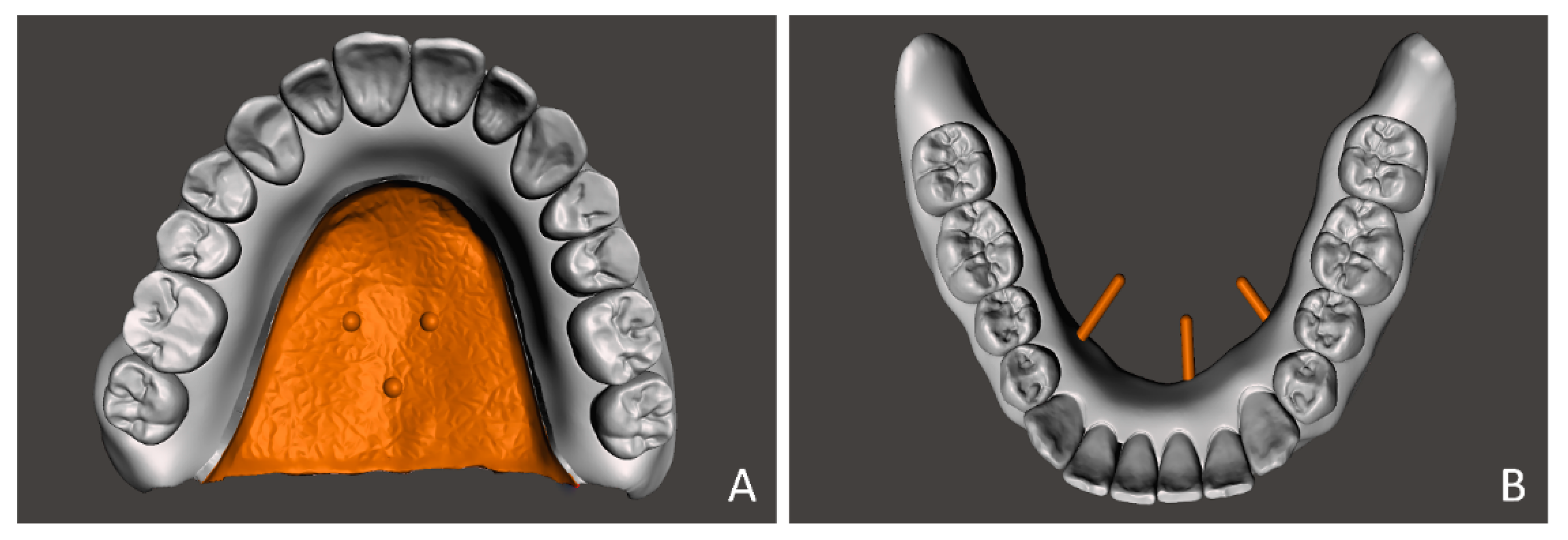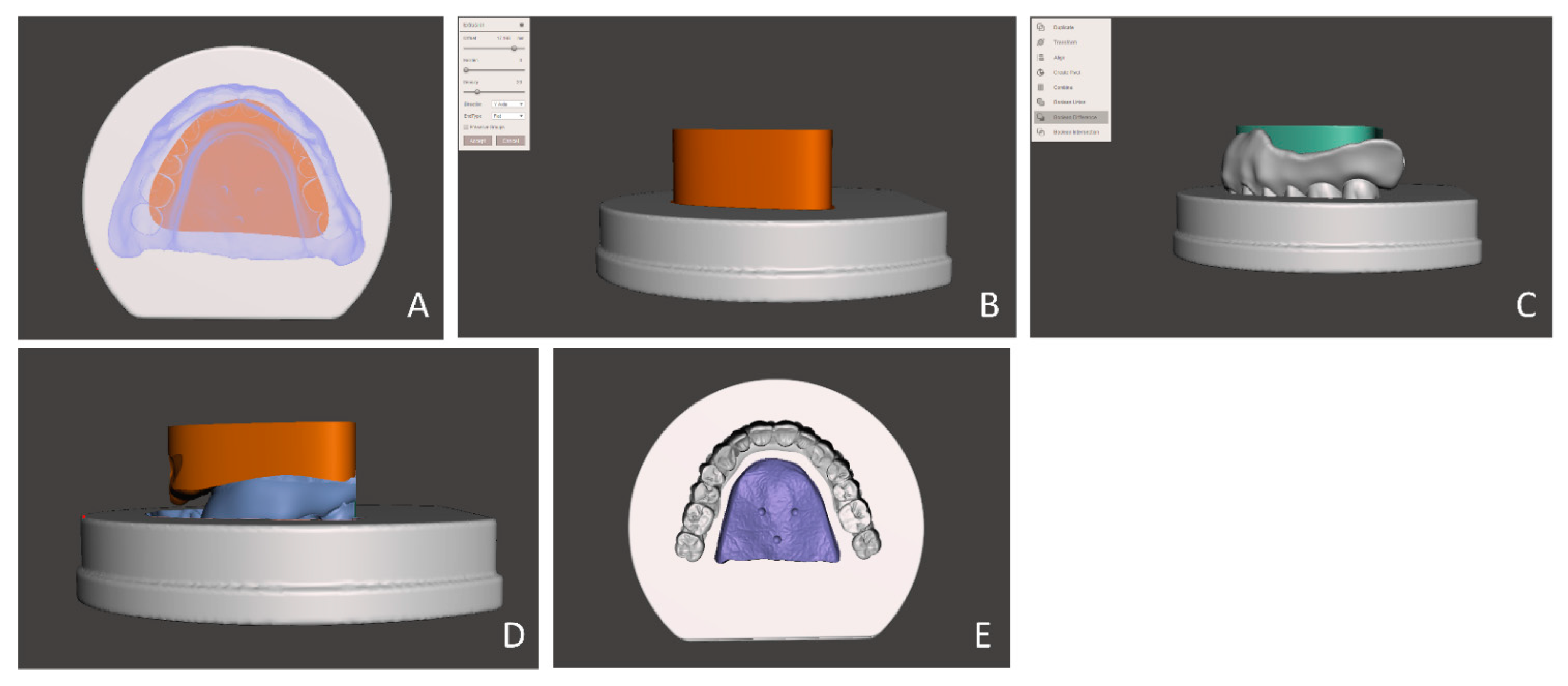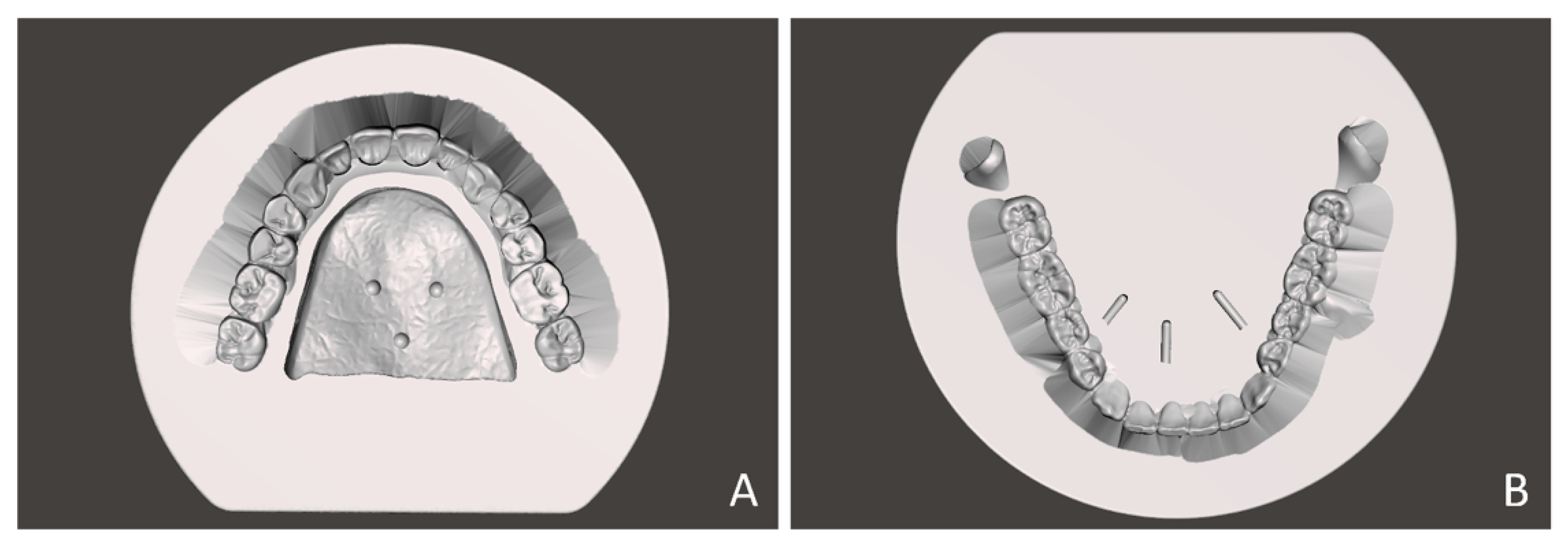Fabrication of Metal-Reinforced Complete Dentures Using the CAD-CAM Technique
Abstract
:1. Introduction
2. Materials and Methods
2.1. Technical Note: Designing Process on the CAD Software
- Digitize the master casts and the occlusal relation record by scanning using a desktop scanner (T500; Medit, Seoul, Korea);
- Design the metal frameworks with the attachments and complete dentures for both arches separately in the CAD software (Exocad DentalCAD 2.4 Plovdiv; Exocad GmbH, Darmstadt, Germany) using the acquired data;
- Replace the denture base with the corresponding tissue surface of the dental cast in the CAD software (Meshmixer; Autodesk, Inc., San Rafael, CA, USA) in the imported standard tessellation language (STL) files. Combine the denture and designed metal framework (Figure 1);
- Extrude the metal portion by 1 mm and export the modified metal-reinforced complete denture data;
- Design the geometry guide for the metal-reinforced complete dentures using the “Boolean command” in the CAD software (Meshmixer; Autodesk, Inc., San Rafael, CA, USA) that contains the negative impression of a part of the metal-reinforced complete dentures (Figure 2);
- Modify the geometry guide design by discarding the labial, mesial, and distal surfaces of the teeth sockets (Figure 3). Export the STL file of the geometry guide.
2.2. Technical Note: Fabrication of Dental Prosthesis
- Mill the artificial teeth from a double cross-linked resin disk (SR Vivodent CAD; Ivoclar Vivadent AG, Schaan, Liechtenstein). Fabricate the metal framework using the lost-wax casting technique after milling the wax pattern (Mazic Wax; VERICOM Co., Ltd., Chuncheon, Korea);
- Mill the geometry guide from the gypsum poured on the metal holder attached to the milling machine. Mill the designs in a milling machine (Rainbow Mill-Zr 2nd; Dentium Co., Ltd., Seoul, Korea) after calculating the toolpath;
- Bond the artificial teeth and the metal framework to the geometry guide (Figure 4);
- Pour autopolymerizing resin (Retec PRESS LT; Retec Kunststofftechnik GmbH, Rosbach, Germany) to fill the space above the geometry guide. Cure the resin using a dental polymerization unit (Palamat elite; Kulzer GmbH, Hanau, Germany) as per the manufacturer’s instructions;
- Set the metal holder that contains the geometry guide, artificial teeth, and metal framework in the milling machine. Mill the denture according to the acquired modified denture data, in which the metal portion is extruded by 1 mm (Figure 5);
- Remove the attachments, gypsum, and resin covering the metal base. Finish the prosthesis by polishing (Figure 6).
3. Discussion
4. Conclusions
Author Contributions
Funding
Institutional Review Board Statement
Informed Consent Statement
Data Availability Statement
Acknowledgments
Conflicts of Interest
References
- Maeda, Y.; Minoura, M.; Tsutsumi, S.; Okada, M.; Nokubi, T. A CAD/CAM system for removable denture. Part I: Fabrication of complete dentures. Int. J. Prosthodont. 1994, 7, 17–21. [Google Scholar] [PubMed]
- Wang, C.; Shi, Y.F.; Xie, P.J.; Wu, J.H. Accuracy of digital complete dentures: A systematic review of in vitro studies. J. Prosthet. Dent. 2021, 125, 249–256. [Google Scholar] [CrossRef] [PubMed]
- Hwang, H.J.; Lee, S.J.; Park, E.J.; Yoon, H.I. Assessment of the trueness and tissue surface adaptation of CAD-CAM maxillary denture bases manufactured using digital light processing. J. Prosthet. Dent. 2019, 121, 110–117. [Google Scholar] [CrossRef] [PubMed]
- Yoon, H.I.; Hwang, H.J.; Ohkubo, C.; Han, J.S.; Park, E.J. Evaluation of the trueness and tissue surface adaptation of CAD-CAM mandibular denture bases manufactured using digital light processing. J. Prosthet. Dent. 2018, 120, 919–926. [Google Scholar] [CrossRef] [PubMed]
- Yoon, S.N.; Oh, K.C.; Lee, S.J.; Han, J.S.; Yoon, H.I. Tissue surface adaptation of CAD-CAM maxillary and mandibular complete denture bases manufactured by digital light processing: A clinical study. J. Prosthet. Dent. 2020, 124, 682–689. [Google Scholar] [CrossRef] [PubMed]
- AlHelal, A.; AlRumaih, H.S.; Kattadiyil, M.T.; Baba, N.Z.; Goodacre, C.J. Comparison of retention between maxillary milled and conventional denture bases: A clinical study. J. Prosthet. Dent. 2017, 117, 233–238. [Google Scholar] [CrossRef] [PubMed]
- Bilgin, M.S.; Baytaroglu, E.N.; Erdem, A.; Dilber, E. A review of computer-aided design/computer-aided manufacture techniques for removable denture fabrication. Eur. J. Dent. 2016, 10, 286–291. [Google Scholar] [CrossRef] [PubMed] [Green Version]
- Belfiglio, E.J. Using metal bases in making complete dentures. J. Prosthet. Dent. 1987, 58, 314. [Google Scholar] [CrossRef]
- Ye, Y.; Jiao, T.; Zhu, J.; Sun, J. Adaptation and micro-structure of Co-Cr alloy maxillary complete denture base plates fabricated by selective laser melting technique. Lasers Med. Sci. 2018, 33, 1025–1030. [Google Scholar] [CrossRef] [PubMed]
- You, S.G.; You, S.M.; Kang, S.Y.; Bae, S.Y.; Kim, J.H. Evaluation of the adaptation of complete denture metal bases fabricated with dental CAD-CAM systems: An in vitro study. J. Prosthet. Dent. 2021, 125, 479–485. [Google Scholar] [CrossRef] [PubMed]
- Oh, K.C.; Jeon, J.; Kim, J.H. Fabrication of a removable partial denture combining conventional and digital techniques. J. Prosthet. Dent. 2021, 125, 588–591. [Google Scholar] [CrossRef] [PubMed]
- Park, C.; Kee, W.; Lim, H.P.; Park, S.W. Combining 3D-printed metal and resin for digitally fabricated dentures: A dental technique. J. Prosthet. Dent. 2020, 123, 389–392. [Google Scholar] [CrossRef] [PubMed]
- Lee, J.J.; Kim, D.H.; Noh, K. A technique for transferring the contours of a functional impression to the polished surfaces of digitally fabricated removable complete dentures. J. Prosthet. Dent. 2020, 124, 153–156. [Google Scholar] [CrossRef] [PubMed]
- Bidra, A.S.; Taylor, T.D.; Agar, J.R. Computer-aided technology for fabricating complete dentures: Systematic review of historical background, current status, and future perspectives. J. Prosthet. Dent. 2013, 109, 361–366. [Google Scholar] [CrossRef]






Publisher’s Note: MDPI stays neutral with regard to jurisdictional claims in published maps and institutional affiliations. |
© 2021 by the authors. Licensee MDPI, Basel, Switzerland. This article is an open access article distributed under the terms and conditions of the Creative Commons Attribution (CC BY) license (https://creativecommons.org/licenses/by/4.0/).
Share and Cite
Piao, X.-Y.; Shim, J.-S.; Park, J.-M. Fabrication of Metal-Reinforced Complete Dentures Using the CAD-CAM Technique. Appl. Sci. 2021, 11, 7369. https://doi.org/10.3390/app11167369
Piao X-Y, Shim J-S, Park J-M. Fabrication of Metal-Reinforced Complete Dentures Using the CAD-CAM Technique. Applied Sciences. 2021; 11(16):7369. https://doi.org/10.3390/app11167369
Chicago/Turabian StylePiao, Xing-Yu, June-Sung Shim, and Ji-Man Park. 2021. "Fabrication of Metal-Reinforced Complete Dentures Using the CAD-CAM Technique" Applied Sciences 11, no. 16: 7369. https://doi.org/10.3390/app11167369






